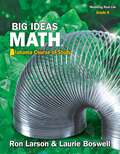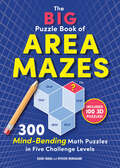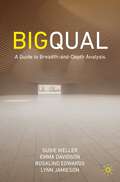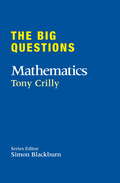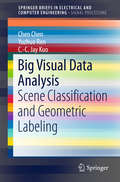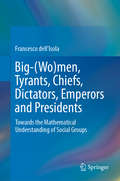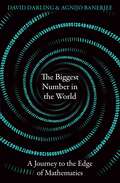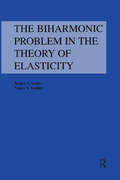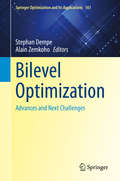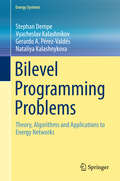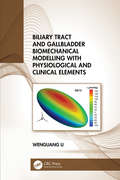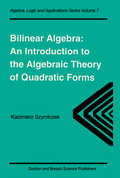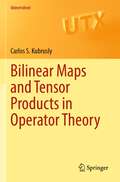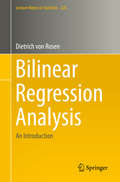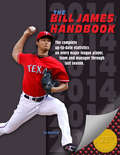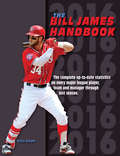- Table View
- List View
Big Ideas Math: Modeling Real Life, Grade K, Volume 1
by Ron Larson Laurie BoswellNIMAC-sourced textbook
Big Ideas Math: Modeling Real Life, Grade K, Volume 2
by Ron Larson Laurie BoswellNIMAC-sourced textbook
Big Ideas Math MS Blue: A Common Core Curriculum, Student Edition
by Ron LarsonThe revised Big Ideas Math series uses the same research-based strategy of a balanced approach to instruction that made the first Big Ideas Math series so successful. This approach opens doors to abstract thought, reasoning, and inquiry as students persevere to answer the Essential Questions that introduce each section. The foundation of the program is the Common Core Standards for Mathematical Content and Standards for Mathematical Practice. Students are subtly introduced to "Habits of Mind" that help them internalize concepts for a greater depth of understanding. These habits serve students well not only in mathematics, but across all curricula throughout their academic careers. The Big Ideas Math series exposes students to highly motivating and relevant problems. Woven throughout the series are the depth and rigor students need to prepare for career-readiness and other college-level courses. In addition, the Big Ideas Math series prepares students to meet the challenge of PARCC and Smarter Balanced testing.
Big Ideas Math (red) Accelerated Pupil Edition
by Ron Larson Laurie BoswellA new edition in the Big Ideas Series of math books which bases its research on the abstraction of thought, reasoning and inquiring as students review the section in answering the Essential Questions. Big Ideas series is known to expose its readers to relevant problems shaping their minds as they prepare for Calculus and college level courses
Big Ideas Math Red Accelerated, Record and Practice Journal
by Big Ideas Learning LLCNIMAC-sourced textbook
The Big Puzzle Book of Area Mazes: 300 Mind-bending Math Puzzles In Five Challenge Levels (Original Area Mazes #0)
by Naoki Inaba Ryoichi MurakamiStretch your brain up, down, and sideways with addictive area mazes! Introducing a new puzzle obsession for sodoku lovers . . . amazing, absorbing area mazes. First invented for gifted students, area mazes blend grade-school math with genius logic. Put down that calculator! You can always find "?" using simple, whole numbers, your wits—and a pencil. Already hooked on area mazes? Venture into the third dimension with 100 3D puzzles, included here for the first time by creator Naoki Inaba. With 300 perplexing problems in all, The Big Puzzle Book of Area Mazes offers hours of brain-building fun, from scratching your head to shouting "aha"!
Big Qual: A Guide to Breadth-and-Depth Analysis
by Susie Weller Emma Davidson Rosalind Edwards Lynn JamiesonThis upper-level textbook presents a new approach to large scale qualitative analysis – the pioneering breadth-and-depth method. It covers the strengths and deployment of “big qual” as a distinct research methodology. The book will appeal to students and researchers across disciplines and methodological backgrounds.The growing availability of large qualitative data sets presents exciting opportunities. Pooling multiple qualitative data sets enhances the possibility of theoretical generalisability and strengthens claims from qualitative research about understanding how social processes work.Given the evolving possibilities that big data offers the humanities and social sciences, this book will be a must-have resource, building capacity and provoking new ways of thinking about qualitative research and its analysis.
The Big Questions: Mathematics
by Tony CrillyIn Big Questions: Mathematics, Tony Crilly answers the 20 key questions:What is math for? Where do numbers come from? Why are primes the atoms of maths? Which are the strangest numbers? Are imaginary numbers real? How big is infinity? Where do parallel lines meet? What is the math of the universe? Are statistics lies? Can math guarantee riches? Is there a formula for everything? Why are three dimensions not enough? Can a butterfly's wings really cause a hurricane? Can we create an unbreakable code? Is math beauty? Can math predict the future? What shape is the universe? What is symmetry? Is math true? Is there anything left to solve?
The Big Questions: Mathematics
by Tony CrillyThe Big Questions series is designed to let renowned experts address the 20 most fundamental and frequently asked questions of a major branch of science or philosophy. Each 3000-word essay simply and concisely examines a question that has eternally perplexed enquiring minds, and provides answers from history's great thinkers. This ambitious project is a unique distillation of humanity's best ideas. In Big Questions: Mathematics, Tony Crilly answers the 20 key questions: What is maths for? Where do numbers come from? Why are primes the atoms of maths? What are the strangest numbers? Are imaginary numbers real? How big is infinity? Where do parallel lines meet? What is the maths of the universe? Are statistics lies? Can maths guarantee riches? Is there a formula for everything? Why are three dimensions not enough? Can a butterfly's wings really cause a hurricane? Can we create an unbreakable code? Is maths beauty? Can maths predict the future? What shape is the universe? What is symmetry? Is maths true? Is there anything left to solve?
The Big Questions: Mathematics
by Tony CrillyThe Big Questions series is designed to let renowned experts address the 20 most fundamental and frequently asked questions of a major branch of science or philosophy. Each 3000-word essay simply and concisely examines a question that has eternally perplexed enquiring minds, and provides answers from history's great thinkers. This ambitious project is a unique distillation of humanity's best ideas. In Big Questions: Mathematics, Tony Crilly answers the 20 key questions: What is maths for? Where do numbers come from? Why are primes the atoms of maths? What are the strangest numbers? Are imaginary numbers real? How big is infinity? Where do parallel lines meet? What is the maths of the universe? Are statistics lies? Can maths guarantee riches? Is there a formula for everything? Why are three dimensions not enough? Can a butterfly's wings really cause a hurricane? Can we create an unbreakable code? Is maths beauty? Can maths predict the future? What shape is the universe? What is symmetry? Is maths true? Is there anything left to solve?
The Big R-Book: From Data Science to Learning Machines and Big Data
by Philippe J. De BrouwerIntroduces professionals and scientists to statistics and machine learning using the programming language R Written by and for practitioners, this book provides an overall introduction to R, focusing on tools and methods commonly used in data science, and placing emphasis on practice and business use. It covers a wide range of topics in a single volume, including big data, databases, statistical machine learning, data wrangling, data visualization, and the reporting of results. The topics covered are all important for someone with a science/math background that is looking to quickly learn several practical technologies to enter or transition to the growing field of data science. The Big R-Book for Professionals: From Data Science to Learning Machines and Reporting with R includes nine parts, starting with an introduction to the subject and followed by an overview of R and elements of statistics. The third part revolves around data, while the fourth focuses on data wrangling. Part 5 teaches readers about exploring data. In Part 6 we learn to build models, Part 7 introduces the reader to the reality in companies, Part 8 covers reports and interactive applications and finally Part 9 introduces the reader to big data and performance computing. It also includes some helpful appendices. Provides a practical guide for non-experts with a focus on business users Contains a unique combination of topics including an introduction to R, machine learning, mathematical models, data wrangling, and reporting Uses a practical tone and integrates multiple topics in a coherent framework Demystifies the hype around machine learning and AI by enabling readers to understand the provided models and program them in R Shows readers how to visualize results in static and interactive reports Supplementary materials includes PDF slides based on the book’s content, as well as all the extracted R-code and is available to everyone on a Wiley Book Companion Site The Big R-Book is an excellent guide for science technology, engineering, or mathematics students who wish to make a successful transition from the academic world to the professional. It will also appeal to all young data scientists, quantitative analysts, and analytics professionals, as well as those who make mathematical models.
Big Visual Data Analysis: Scene Classification and Geometric Labeling (SpringerBriefs in Electrical and Computer Engineering)
by C.-C. Jay Kuo Chen Chen Yuzhuo RenThis book offers an overview of traditional big visual data analysis approaches and provides state-of-the-art solutions for several scene comprehension problems, indoor/outdoor classification, outdoorscene classification, and outdoor scene layout estimation. It is illustrated with numerous naturaland synthetic color images,and extensive statistical analysis is provided to help readers visualize big visualdata distribution and the associatedproblems. Although therehas been some research on big visual data analysis, little workhas been published on big image data distribution analysis using the modernstatistical approach described in thisbook. By presenting a complete methodology on big visual data analysis withthree illustrative scene comprehensionproblems, it provides ageneric framework that canbe applied to other big visual data analysis tasks.
Big-(Wo)men, Tyrants, Chiefs, Dictators, Emperors and Presidents: Towards the Mathematical Understanding of Social Groups
by Francesco dell'IsolaThis book highlights mathematical ideas to help explain a number of important aspects of the dynamics of social groups. These ideas are similar to those used to describe the behaviour of Lagrangian mechanical systems, and as such this book appeals to anyone wanting to gain an understanding of the intrinsic unity of natural phenomena.
The Biggest Number in the World: A Journey to the Edge of Mathematics
by David Darling Agnijo BanerjeeFrom cells in our bodies to measuring the universe, big numbers are everywhere We all know that numbers go on forever, that you could spend your life counting and never reach the end of the line, so there can&’t be such a thing as a &‘biggest number&’. Or can there? To find out, David Darling and Agnijo Banerjee embark on an epic quest, revealing the answers to questions like: are there more grains of sand on Earth or stars in the universe? Is there enough paper on Earth to write out the digits of a googolplex? And what is a googolplex? Then things get serious. Enter the strange realm between the finite and the infinite, and float through a universe where the rules we cling to no longer apply. Encounter the highest number computable and infinite kinds of infinity. At every turn, a cast of wild and wonderful characters threatens the status quo with their ideas, and each time the numbers get larger.
Biharmonic Problem in the Theory of Elasticity
by Sergey A. LurieThis reference work offers a method of deriving exact solutions to the biharmonic equation in the context of elasticity problems, and proposes a number of new solutions. Beginning with an in-depth presentation of a general mathematical model, this text proceeds to outline specific applications, extending the developed method to special harmonic problems of mechanics for conjugated domains. All applications are illustrated with numerical examples.
Bilevel Optimization: Advances and Next Challenges (Springer Optimization and Its Applications #161)
by Stephan Dempe Alain Zemkoho2019 marked the 85th anniversary of Heinrich Freiherr von Stackelberg’s habilitation thesis “Marktform und Gleichgewicht,” which formed the roots of bilevel optimization. Research on the topic has grown tremendously since its introduction in the field of mathematical optimization. Besides the substantial advances that have been made from the perspective of game theory, many sub-fields of bilevel optimization have emerged concerning optimal control, multiobjective optimization, energy and electricity markets, management science, security and many more. Each chapter of this book covers a specific aspect of bilevel optimization that has grown significantly or holds great potential to grow, and was written by top experts in the corresponding area. In other words, unlike other works on the subject, this book consists of surveys of different topics on bilevel optimization. Hence, it can serve as a point of departure for students and researchers beginning their research journey or pursuing related projects. It also provides a unique opportunity for experienced researchers in the field to learn about the progress made so far and directions that warrant further investigation. All chapters have been peer-reviewed by experts on mathematical optimization.
Bilevel Programming Problems: Theory, Algorithms and Applications to Energy Networks (Energy Systems)
by Stephan Dempe Vyacheslav Kalashnikov Gerardo A. Pérez-Valdés Nataliya KalashnykovaThis book describes recent theoretical findings relevant to bilevel programming in general, and in mixed-integer bilevel programming in particular. It describes recent applications in energy problems, such as the stochastic bilevel optimization approaches used in the natural gas industry. New algorithms for solving linear and mixed-integer bilevel programming problems are presented and explained.
Biliary Tract and Gallbladder Biomechanical Modelling with Physiological and Clinical Elements
by Wenguang LiGallstone and other diseases of the biliary tract affect more than around 20% of the adult population. The complications of gallstones, acute pancreatitis and obstructive jaundice, can be lethal. This is the first book to systematically treat biliary tract and gallbladder modelling with physiological and clinical information in a biomechanical context. The book provides readers with detailed biomechanical modelling procedures for the biliary tract and gallbladder based on physiological information, clinical observations and experimental data and with the results properly interpreted in terms of clinical diagnosis and with biomechanical mechanisms for biliary diseases. The text can be used as a reference book for university undergraduates, postgraduates and professional researchers in applied mathematics, biomechanics, biomechanical engineering and biomedical engineering, as well as related surgeons.
Bilinear Algebra: An Introduction to the Algebraic Theory of Quadratic Forms (Algebra, Logic And Applications Ser. #Vol. 7)
by Kazimierz SzymiczekGiving an easily accessible elementary introduction to the algebraic theory of quadratic forms, this book covers both Witt's theory and Pfister's theory of quadratic forms. Leading topics include the geometry of bilinear spaces, classification of bilinear spaces up to isometry depending on the ground field, formally real fields, Pfister forms, the Witt ring of an arbitrary field (characteristic two included), prime ideals of the Witt ring, Brauer group of a field, Hasse and Witt invariants of quadratic forms, and equivalence of fields with respect to quadratic forms. Problem sections are included at the end of each chapter. There are two appendices: the first gives a treatment of Hasse and Witt invariants in the language of Steinberg symbols, and the second contains some more advanced problems in 10 groups, including the u-invariant, reduced and stable Witt rings, and Witt equivalence of fields.
Bilinear Maps and Tensor Products in Operator Theory (Universitext)
by Carlos S. KubruslyThis text covers a first course in bilinear maps and tensor products intending to bring the reader from the beginning of functional analysis to the frontiers of exploration with tensor products. Tensor products, particularly in infinite-dimensional normed spaces, are heavily based on bilinear maps. The author brings these topics together by using bilinear maps as an auxiliary, yet fundamental, tool for accomplishing a consistent, useful, and straightforward theory of tensor products. The author’s usual clear, friendly, and meticulously prepared exposition presents the material in ways that are designed to make grasping concepts easier and simpler. The approach to the subject is uniquely presented from an operator theoretic view. An introductory course in functional analysis is assumed. In order to keep the prerequisites as modest as possible, there are two introductory chapters, one on linear spaces (Chapter 1) and another on normed spaces (Chapter 5), summarizing the background material required for a thorough understanding. The reader who has worked through this text will be well prepared to approach more advanced texts and additional literature on the subject.The book brings the theory of tensor products on Banach spaces to the edges of Grothendieck's theory, and changes the target towards tensor products of bounded linear operators. Both Hilbert-space and Banach-space operator theory are considered and compared from the point of view of tensor products. This is done from the first principles of functional analysis up to current research topics, with complete and detailed proofs. The first four chapters deal with the algebraic theory of linear spaces, providing various representations of the algebraic tensor product defined in an axiomatic way. Chapters 5 and 6 give the necessary background concerning normed spaces and bounded bilinear mappings. Chapter 7 is devoted to the study of reasonable crossnorms on tensor product spaces, discussing in detail the important extreme realizations of injective and projective tensor products. In Chapter 8 uniform crossnorms are introduced in which the tensor products of operators are bounded; special attention is paid to the finitely generated situation. The concluding Chapter 9 is devoted to the study of the Hilbert space setting and the spectral properties of the tensor products of operators. Each chapter ends with a section containing “Additional Propositions" and suggested readings for further studies.
Bilinear Regression Analysis: An Introduction (Lecture Notes In Statistics Ser. #220)
by Dietrich Von RosenThis book expands on the classical statistical multivariate analysis theory by focusing on bilinear regression models, a class of models comprising the classical growth curve model and its extensions. In order to analyze the bilinear regression models in an interpretable way, concepts from linear models are extended and applied to tensor spaces. Further, the book considers decompositions of tensor products into natural subspaces, and addresses maximum likelihood estimation, residual analysis, influential observation analysis and testing hypotheses, where properties of estimators such as moments, asymptotic distributions or approximations of distributions are also studied. Throughout the text, examples and several analyzed data sets illustrate the different approaches, and fresh insights into classical multivariate analysis are provided. This monograph is of interest to researchers and Ph.D. students in mathematical statistics, signal processing and other fields where statistical multivariate analysis is utilized. It can also be used as a text for second graduate-level courses on multivariate analysis.
The Bill James Handbook 2014
by Bill JamesThe Bill James Handbook--the first, best, most complete annual baseball reference guide available. Full of exclusive stats, this book is the most comprehensive resource on every hit, pitch, and catch in Major League Baseball's 2013 season--and includes player projections for 2014. Key features include: NEW sections: No-Hitter Summary; Home Run Robberies; Hitter Analysis; and returning favorites: Career Baserunning; Pitcher Analysis; Pitch Repertoire Section; Rotation vs. Bullpen.
Bill James Handbook 2015
by Bill JamesThe first, best, most complete annual baseball reference guide available. Full of exclusive stats, this book is the most comprehensive resource on every hit, pitch, and catch in Major League Baseball's 2014 season--and includes player projections for 2015.
The Bill James Handbook 2017
by Baseball Info Solutions Bill JamesBill James and the Baseball Info Solutions team of analysts continue to pack in new content, including a fresh look at the continued rise and effectiveness of The Shift and a new breakdown of home runs and long flyouts. And, as always, the book forecasts fresh hitter and pitcher projections for those looking to get an early jump on the next season.
